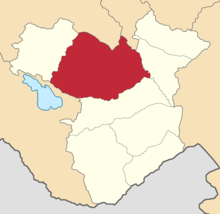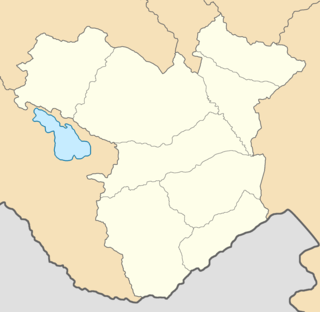
The Elizavetpol Governorate, also known after 1918 as the Ganja Governorate, was a province (guberniya) of the Caucasus Viceroyalty of the Russian Empire, with its capital in Yelisavetpol. The area of the governorate stretched 38,922.43 square versts and was composed of 1,275,131 inhabitants in 1916. The Elizavetpol Governorate bordered the Erivan Governorate to the west, the Tiflis Governorate and Zakatal Okrug to the north, the Dagestan Oblast to the northeast, the Baku Governorate to the east, and Iran to the south.

The Borchaly uezd was a county (uezd) of the Tiflis Governorate of the Caucasus Viceroyalty of the Russian Empire, and later of the independent and Soviet republics of Georgia. Its administrative center was the town of Shulavery. The area of the county roughly corresponded to the contemporary Lori Province of Armenia and the Kvemo Kartli region of Georgia.

The Jevanshir uezd was a county (uezd) of the Elizavetpol Governorate of the Russian Empire, with its center in Terter.
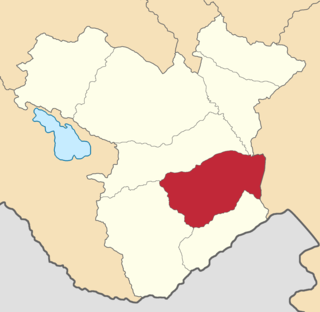
The Shusha uezd was a county (uezd) of the Elizavetpol Governorate of the Russian Empire, and then of the Ganja Governorate of Azerbaijan Democratic Republic with its center in Shusha in 1840–1921.

The Jebrail uezd, also known after 1905 as the Karyagino uezd, was a county (uezd) of the Elizavetpol Governorate of the Russian Empire with its center in Jebrail (Jabrayil) from 1873 until its formal abolition in 1921 by the Soviet authorities.

The Kazakh uezd was a county (uezd) of the Elizavetpol Governorate of the Russian Empire and later of the Azerbaijan Democratic Republic with its center in Kazakh from 1868 until its formal abolition in 1929 by the Soviet authorities of the Azerbaijan SSR. The area of the Kazakh uezd forms a large part of the modern-day Tavush Province and a small northeastern part of the Gegharkunik Province of Armenia, also forming most of the area of the Agstafa, Tovuz and Qazax districts of Azerbaijan.
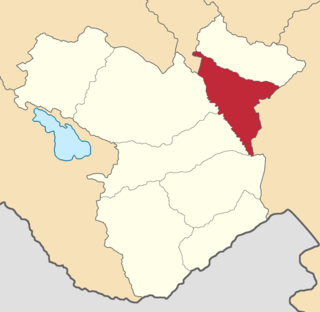
The Aresh uezd, later known as the Agdash uezd, was a county (uezd) of the Elizavetpol Governorate of the Russian Empire and later of the Azerbaijan Democratic Republic with its center in Aresh from 1874 until its formal abolition in 1929 by Soviet authorities.

The Nukha uezd was a county (uezd) of the Elizavetpol Governorate of the Russian Empire and later of the Azerbaijan Democratic Republic with its center in Nukha from 1868 until its formal abolition in 1921 by the Soviet authorities of the Azerbaijan SSR.

The Erivan uezd was a county (uezd) of the Erivan Governorate of the Caucasus Viceroyalty of the Russian Empire. The uezd bordered the Etchmiadzin and Surmalu uezds to the west, the Nor Bayazet uezd to the east, the Sharur-Daralayaz uezd to the south, and Iran to the southwest. It included most of the Ararat Province and southern parts of the Kotayk Province of central Armenia, the Sadarak District of the Nakhchivan exclave of Azerbaijan, and the Aras corridor of the Aralık District of the Iğdır Province of Turkey. The administrative centre of the county was the city of Erivan.

The Sharur-Daralayaz uezd was a county (uezd) of the Erivan Governorate of the Caucasus Viceroyalty of the Russian Empire. It bordered the governorate's Erivan and Nor Bayazet uezds to the north, the Nakhichevan uezd to the south, the Zangezur and Jevanshir uezds of the Elizavetpol Governorate to the east, and Persia to the southwest. It included most of the Vayots Dzor Province of present-day Armenia and the Sharur District of the Nakhchivan exclave of present-day Azerbaijan. The administrative centre of the county was Bashnorashen.

The Dagestan Oblast was a province (oblast) of the Caucasus Viceroyalty of the Russian Empire. It roughly corresponded to most of present-day southeastern Dagestan within the Russian Federation. The Dagestan oblast was created in 1860 out of the territories of the former Caucasian Imamate, bordering the Terek Oblast to the north, the Tiflis Governorate and Zakatal Okrug to the west, the Elizavetpol Governorate to the south, and Baku Governorate to the east. The administrative center of the oblast was Temir-Khan-Shura.

The Nor Bayazet or Novobayazet uezd was a county (uezd) of the Erivan Governorate of the Caucasus Viceroyalty of the Russian Empire. The uezd bordered the Alexandropol uezd to the north, the Etchmiadzin and Erivan uezds to the west, the Sharur-Daralayaz uezd to the south, and the Kazakh, Elizavetpol, and Jevanshir uezds of the Elizavetpol Governorate to the east. Centered on Lake Sevan, the Nor Bayazet uezd included most of the contemporary province of Gegharkunik and northern parts of the Kotayk Province of Armenia. The administrative center of the uezd was the city Novobayazet for which the district was eponymously named.
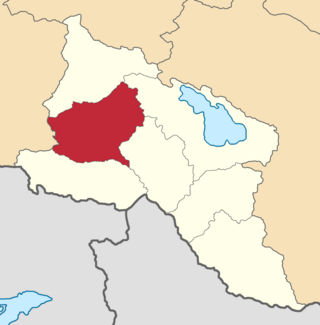
The Etchmiadzin uezd was a county (uezd) of the Erivan Governorate of the Caucasus Viceroyalty of the Russian Empire. The uezd bordered the Alexandropol uezd to the north, the Nor Bayazet uezd to the east, Erivan uezd to the north, the Surmalu uezd to the south, and the Kars Oblast to the west. It included all of the Armavir Province and most of the Aragatsotn Province of present-day Armenia. The administrative centre of the county was Vagorshapat (Vagharshapat), also referred to as Etchmiadzin—the administrative capital of the Armenian Apostolic Church.

The Ozurgeti uezd was a county (uezd) of the Kutaisi Governorate of the Caucasus Viceroyalty of the Russian Empire. It bordered the Senaki uezd to the north, the Kutaisi uezd to the east, the Akhaltsikhe uezd of the Tiflis Governorate to the southeast, the Batum Okrug of the Batum Oblast to the south, and the Black Sea to the west. The area of the Ozurgeti uezd corresponded to most of the contemporary Guria region of Georgia. The county was eponymously named for its administrative center, Ozurgeti.

The Baku uezd was a county (uezd) within the Baku Governorate of the Russian Empire and then of Azerbaijan Democratic Republic and Azerbaijan SSR until its formal abolishment in 1929. The uezd was located in eastern part of the Baku Governorate, bordering Caspian Sea to the east, Shemakha uezd to the west, Kuba uezd to the north and Lenkoran uezd to the south. The administrative center of the uezd was the village Sarai.

The Lenkoran uezd or Talysh uezd was a county (uezd) within the Baku Governorate of the Russian Empire, and then of the Azerbaijan Democratic Republic and the Azerbaijan SSR until its formal abolishment in 1929. The county was located on the southern part of the governorate, bordering Caspian Sea to the east, Javad uezd to the north, and Iran to the southwest. The administrative centre of the county was the city of Lenkoran.

The Shemakha uezd was a county (uezd) within the Baku Governorate of the Russian Empire, and then of Azerbaijan Democratic Republic and Azerbaijan SSR until its formal abolishment in 1929. The county was located in central part of the Baku Governorate, bordering the Javad uezd to the south, Baku uezd to the east, Geokchay uezd to the west and Kuba uezd to the north. The administrative centre of the county was the city of Shemakha.

The Geokchay uezd was a county (uezd) of the Baku Governorate of the Russian Empire and then of the Azerbaijan Democratic Republic and Azerbaijan SSR until its formal abolishment in 1929. The uezd was located in the central part of the governorate, bordering the Kuba uezd to the north, the Shemakha uezd to the east, the Javad uezd to the south and the Elizavetpol Governorate to the west. The administrative center of the uezd was the city of Geokchay.

The Tiflis uezd was a county (uezd) of the Tiflis Governorate of the Caucasus Viceroyalty of the Russian Empire, and then of Democratic Republic of Georgia, with its administrative centre in Tiflis. The area of the uezd roughly corresponded to the contemporary Kvemo Kartli region of Georgia. The district bordered the Telavi uezd to the northeast, the Tionety and Dusheti uezds to the north, the Gori uezd to the northwest, the Borchaly uezd to the west, the Kazakh uezd of the Elizavetpol Governorate to the south, and the Signakh uezd to the east.
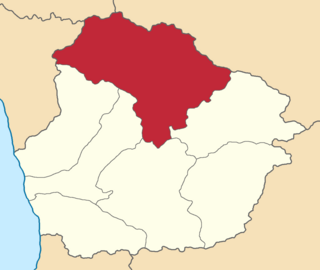
The Lechkhumi uezd was a county (uezd) of the Kutaisi Governorate of the Caucasus Viceroyalty of the Russian Empire. It bordered the Terek and Kuban oblasts to the north, the Sukhumi Okrug to the west, the Zugdidi, Senaki, and Kutais uezds to the south and the Racha uezd to the east. The area of the uezd corresponded to most of the contemporary Samegrelo-Zemo Svaneti region of Georgia. The administrative center of the Lechkhumi uezd was the town of Tsageri.
